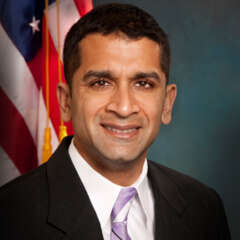Speakers
6 speakers
Date & Time
Aug 19, 2021 2:00 p.m. ET
Webinar
Date: On Demand
Duration: 1 hour
Cost: No Fee
In the age of remote working, coupled with a mobile-first approach to application development, an organization’s network perimeter consists of user end points. That makes securing end points an important part of the organization’s cybersecurity strategy.
Prompted by the recent White House executive order on cybersecurity, federal agencies are accelerating adoption of zero trust architectures, and they’re including end points in that effort.
In a webinar convened by Federal News Network and Tanium, Nick Ward, the chief information security officer (CISO) at the Justice Department, summed it up.
“The executive order for cybersecurity has really driven us towards zero trust framework,” Ward said. “We have certainly embraced that idea. It’s actually a very good framework for this hybrid type environment, because it helps us look at devices and device security, with without regard to how that network operates.”
In the new normal “we have to be ready for 100% telework at any time,” added Gerald Caron III, the chief information officer of the Office of Inspector General at the Health and Human Services Department. Caron said that the zero trust approach must operate so as not to degrade performance or the user experience. He said modernizing user-to-cloud connections away from virtual private networks will mitigate latencies caused by VPN traffic routed from the data center back out to the cloud – the so-called boomerang or hairpinning effect.
For the U.S. Patent and Trademark Office, that means use of the security access service edge model. “It does support zero trust network access for secure remote access by distributing secure configurations to all devices, whether mobile or other devices within our infrastructure,” said CISO Don Watson.
App vetting, on-device containers, encryption, geo-IP address resolution, and user anomaly detection are among the other techniques panelists said they are using for keeping end points secure.
Matthew Marsden, the vice president and technical account manager for federal at Tanium, said that given the variety of end points and local access networks, agencies need to establish a policy framework for managing endpoints individually.
“A person that’s working from a local coffee shop and connecting to [agency] services through a government issued and managed device is a very different risk decision than somebody connecting through their phone on their home network, or maybe their phone from a corporate WiFi,” Marsden said. He added, “There’s so many decisions that need to be made in real time in order to not hinder user performance or in order to maintain productivity for the workforce. So as we bring new and different devices online, being able to quickly assess those devices and push individual policies that are situational is going to be critical.”
Learning objectives:
- Supporting the hybrid workforce
- Best practices for endpoint security
- Infrastructure and securing devices
Complimentary Registration
Please register using the form on this page or call (202) 895-5023.
This program is sponsored by 
How to access the content: Please note, you may need to re-enter your registration information if you previously registered for this webinar and returned to page after clearing your cookies or using a private browser.
Speakers

Nick Ward
Chief Information Security Officer, Department of Justice

Gerald J. Caron III
Chief Information Officer and Assistant Inspector General for Information Technology, Office of the Inspector General, Department of Health and Human Services

Don Watson
Chief Information Security Officer, U.S. Patent and Trademark Office

Vijay D’Souza
Director, Information Technology and Cybersecurity, U.S. Government Accountability Office

Matthew Marsden
Vice President, Technical Account Management, Federal, Tanium

Tom Temin
Host, The Federal Drive, Federal News Network
Please register using the form on this page.
Have questions or need help? Visit our Q&A page for answers to common questions or to reach a member of our team.
